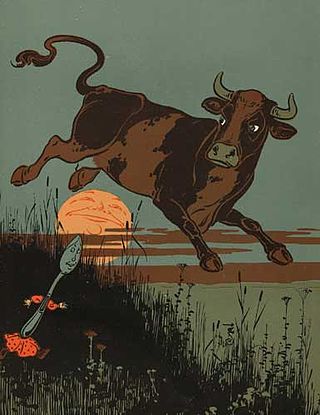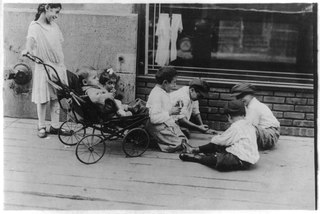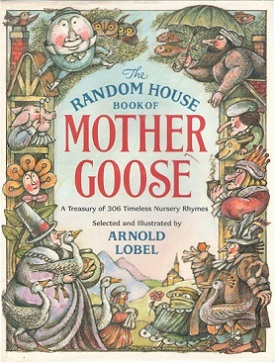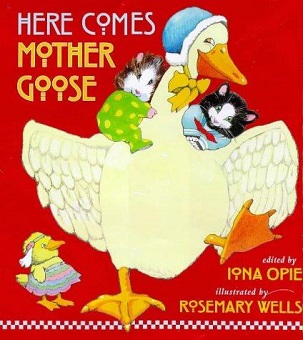
A nursery rhyme is a traditional poem or song for children in Britain and other European countries, but usage of the term dates only from the late 18th/early 19th century. The term Mother Goose rhymes is interchangeable with nursery rhymes.

Humpty Dumpty is a character in an English nursery rhyme, probably originally a riddle and one of the best known in the English-speaking world. He is typically portrayed as an anthropomorphic egg, though he is not explicitly described as such. The first recorded versions of the rhyme date from late eighteenth-century England and the tune from 1870 in James William Elliott's National Nursery Rhymes and Nursery Songs. Its origins are obscure, and several theories have been advanced to suggest original meanings.

Mother Goose is a character that originated in children's fiction, as the imaginary author of a collection of French fairy tales and later of English nursery rhymes. She also appeared in a song, the first stanza of which often functions now as a nursery rhyme. The character also appears in a pantomime tracing its roots to 1806.

"Hey Diddle Diddle" is an English nursery rhyme. It has a Roud Folk Song Index number of 19478.

"Peter Peter Pumpkin Eater" is an English language nursery rhyme. It has a Roud Folk Song Index number of 13497.

"Little Jack Horner" is a popular English nursery rhyme with the Roud Folk Song Index number 13027. First mentioned in the 18th century, it was early associated with acts of opportunism, particularly in politics. Moralists also rewrote and expanded the poem so as to counter its celebration of greediness. The name of Jack Horner also came to be applied to a completely different and older poem on a folkloric theme; and in the 19th century, it was claimed that the rhyme was originally composed in satirical reference to the dishonest actions of Thomas Horner in the Tudor period.

"Ring a Ring o' Roses", "Ring a Ring o' Rosie", or "Ring Around the Rosie", is a nursery rhyme, folk song and playground singing game. Descriptions first emerge in the mid-19th century, but are reported as dating from decades before, and similar rhymes are known from across Europe, with various lyrics. It has a Roud Folk Song Index number of 7925.
A children's song may be a nursery rhyme set to music, a song that children invent and share among themselves or a modern creation intended for entertainment, use in the home or education. Although children's songs have been recorded and studied in some cultures more than others, they appear to be universal in human society.

Mother Goose in Prose is a collection of twenty-two children's stories based on Mother Goose nursery rhymes. It was the first children's book written by L. Frank Baum, and the first book illustrated by Maxfield Parrish. It was originally published in 1897 by Way and Williams of Chicago, and re-released by the George M. Hill Company in 1901.
"Cock a Doodle Doo" is an English nursery rhyme.
Iona Margaret Balfour Opie, and Peter Mason Opie were an English married team of folklorists who applied modern techniques to understanding children's literature and play, in studies such as The Oxford Dictionary of Nursery Rhymes (1951) and The Lore and Language of Schoolchildren (1959). They were also noted anthologists, assembled large collections of children's literature, toys, and games and were regarded as world-famous authorities on children's lore and customs.

"Little Tommy Tucker" is an English language nursery rhyme. It has a Roud Folk Song Index number of 19618.

Childlore is the folklore or folk culture of children and young people. It includes, for example, rhymes and games played in the school playground. The best known researchers of the field were Iona and Peter Opie.
Tommy Thumb's Pretty Song-Book is the first extant anthology of English nursery rhymes, published in London in 1744. It contains the oldest printed texts of many well-known and popular rhymes, as well as several that eventually dropped out of the canon of rhymes for children. A copy is held in the British Library. In 2013 a facsimile edition with an introduction by Andrea Immel and Brian Alderson was published by the Cotsen Occasional Press.
"Girls and Boys Come Out to Play" or "Boys and Girls Come Out to Play" is a nursery rhyme that has existed since at least 1708. It has a Roud Folk Song Index number of 5452.

Gammer Gurton's Garland: or, The Nursery Parnassus, edited by the literary antiquary Joseph Ritson, is one of the earliest collections of English nursery rhymes. It was first published as a chapbook in 1784, but was three times reprinted in expanded editions during the following century, as were several unrelated children's books with similar titles. Gammer Gurton's Garland put into print for the first time some of our best-known nursery rhymes.

My Very First Mother Goose is a 1996 children's picture book by Iona Opie. It is a collection of sixty-eight nursery rhymes, chosen by Opie from the Mother Goose oeuvre, and illustrated by Rosemary Wells.

The Random House Book of Mother Goose: a Treasury of More Than 300 Classic Nursery Rhymes is a 1986 collection of over 300 nursery rhymes by Arnold Lobel. It was republished in 1997 as The Arnold Lobel Book of Mother Goose.

Here Comes Mother Goose is a children's picture book by Iona Opie. It is a collection of 56 Mother Goose nursery rhymes, chosen by Opie and is the second such collaboration between her and illustrator Rosemary Wells.














